
|   |

|   |
Nrityaparva: Festival of Sattriya Dances - Sruti Bandopadhay e-mail: srutibandopadhay2@gmail.com Photos: Arup Jyoti Kalita December 15, 2022 Introduction Nrityaparva is an annual event of the Sattriya Kendra, Guwahati. Being under the project of Sangeet Natak Akademi to support the tradition of Sattriya dance and its allied arts, Nrityaparva was held from November 15 to 18, 2022 at Guwahati. A close look at the program brochure revealed the aim of this festival. Traditional performances, showcasing of the different generations of artists, as well as group, duet and trio presentations were the highlight of the festival. The occasion was also garnished with significant talks and paper presentations on November 16, 17 and 18 mornings, which not only gave the scope of discussion of various issues but also came out as an exercise of knowledge meet. Through these events, Nrityaparva stood out as an important festival of the region, where patronisation of local arts gained prominence and made the indigenous people proud. The festival was inaugurated by the eminent Sattriya Guru Jatin Goswami and the Uttar Kamalabari Majuli Sattradhikar-Prabhu Janardhandev Goswami. Each day, the festival started with an exhibition of gayan bayan, an instrument play accompanied by songs and dance movements. The instruments are khol (percussion) and taal (cymbals). One can visualise at least three types of khol used in different Sattras in the festival. Originally khol used to be constructed by clay, but these days wood is used for the manufacture of the instrument as this provided the instrument with longer life. The festival carefully curated by the Sattriya Kendra took into consideration various factors. The selection of artists was extremely delicate issue as there were considerable numbers of applications. The foremost factor was to uphold the benchmark of Sattriya, both at the Sattras and at the proscenium levels. The idea of commencing each day with the traditional gayan bayan was itself an introduction to the original form. The monks of each Sattra performed with dedication and the songs and rhythmic compositions gave an insight to the richness of performance in the Sattras. The Gayan-Bayan: The beginning on each day 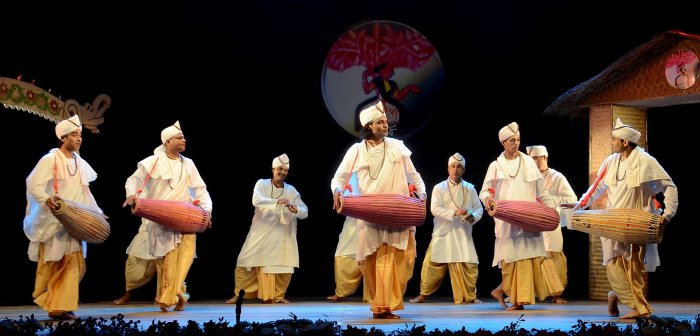 Madhya Majuli Sri Sri Kamalabari Sattra The program on November 15 started with the gayan bayan display of the Madhya Majuli Sri Sri Kamalabari Sattra, which is one among the four Kamalabari Sattras. The show began with the display of eight beat tala and the performers swayed from left to right in the rhythm of the tala. While the singers (gayan) continuously keep the beats in the taal or the cymbals held in hand, the khol players (bayan) play the rhythmic compositions. The songs in the kirtana style mesmerized the audience. The feet too kept the rhythm with many positions that may be found in the shastras of our ancient texts. The bayans played the khol together in perfect synchronization. The participants were Jodumani Borah Borbayan, Diganta Saikia Gayan, Ranjit Hazarika Gayan, Nupur Borah Gayan, Prosanta Bharali Gayan, Deha Saikia Borbayan, Upen Bharali Bayen, Papul Saikia Bayen, Satyen Dutta Bayen, Ratul Bhuyan Bayan. On November 16, the Bishnu Jyoti Sangha, Dhemaji, put up the Mridangia gayan bayan. Established in1978 at Amulguri village of Dhemaji district, this Sangha is inspired by the ideals of Bishnu Prasad Rabha and Jyoti Prasad Agarwala and performs at various cultural functions. The khols in this looked like mridangam as the two sides had larger playing space than the usual khol, which has one large space and a small space on the two sides. These were wrapped with the traditional white gamocha. The sound of this khol was distinctly different from the usual khol. The sound was heavier. Even the taal or the cymbals had bigger diameter to suit the sound of the mridanga khol. In the traditional costume with the white pag, the white dhoti and chadar the performers looked elegant. A light green gamocha chadar hung from the neck gave the desired aesthetics to the performance. The participants were Putul Sonowal, Binod Borah, Tolan Deka, Gojen Sonowal, Dharmeswar Sonowal, Khageshwar Sonowal, Bijon Bora, Khagen Sonowal, Dronakanta Daflari, Keshab Saikia, Rupen Sonowal. 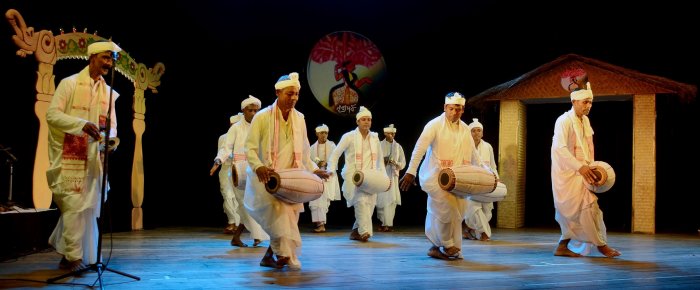 Sri Sri Anirudha Dev Sangeet Kala Tirtha On November 17, Sri Sri Aniruddha Dev Sangeet Kala Tirtha, Majuli, put up another demonstration of the Mridangia gayan bayan. More than fifteen years old, this institute performs and promotes Sattriya dance. This performance highlighted the songs and the style of singing. The main singer stood on a side and sang in the mike, while the other singers joined after him. The matter of the songs followed the usual Vaishnava themes. These men wore white turbans and were all in white clothes, hanging white gamochas with red embroidered borders. The performers were Chandrakanta Borbayan, Chandradhar Das, Ramen Das, Thaneswar Das, Bogiram Das and Gopal Chandra Das as bayan, while the gayans were Bishnu Das, Dinakanta Das, Pratap Das and Bhagyaman Das. 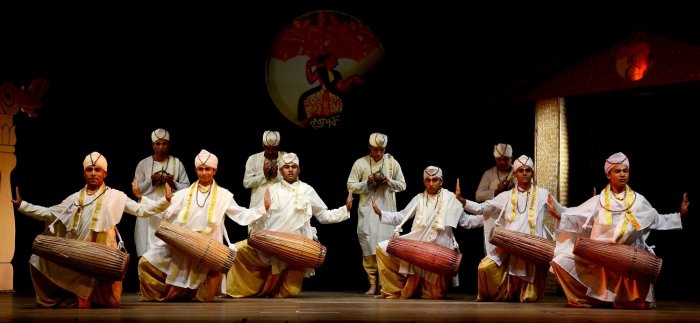 Sri Sri Dhuwahat Beloguri Sattra Kristi Kendra from Narayanpur, Lakhimpur On November 18, Sri Sri Dhuwahat Beloguri Sattra Krishti Kendra, Narayanpur, Lakhimpur, which was established in 1986, put up the gayan bayan performance. An appreciable professional attitude of the group for the proscenium was noticed. The positioning of the gayans and the bayans on the stage, the use of the space were indicative of choreography within the traditional space. Also the rhythm and the speed of the syllables were innovative. The khols were well tuned and the movements too were coordinated among the bayans. The feet and hand movements while playing the khol synchronised well. The movements of gayans were also significant and the cymbals sounded melodious. All the men wore muga-coloured dhoti with a red border, white coloured kurtas with white chadar spread at the back. Even the pag with neat border was a treat to the eyes. Overall performance made a very impressive impact in the audience. Maniram Baruah, Tushar Dutta, Pranjal Hazarika, Binod Neog, Ratul Hazarika, Dhrubajyoti Saikia were the bayans and Prabhat Kakoti, Proshanta Borah, Bapuram Borah, Ankur Kakoti were the gayans. The Solos There were five solo Sattriya dance presentations in the festival. On the first day Dr Meernanda Borthakur, a disciple of Guru Jatin Goswami, placed her dance recital. An Ustad Bismillah Khan Yuva Puraskar of Sangeet Natak Akademi awardee, she has performed extensively in different festivals all over India. She initiated her program with the first Ramdani of Rojaghoria Chalinaas followed by a nritya abhinaya composed by Guru Jatin Goswami on Haramohana based on the writing of Mahaprabhu Srimanta Sankardeva. The concept of the item is by Anjali Borthakur. During the churning of the ocean, Samudramanthan, amrit or nectar emerged. To prevent the demons from possessing the amrit, Lord Vishnu takes the disguise of a beautiful woman, Mohini, to attract the demons and divert them from acquiring the amrit. Lord Shiva also takes a glimpse of Mohini and gets attracted to this illusion or maya. Having coming to his senses, Shiva realises and falls at the lotus feet of Vishnu and accepts that Vishnu is the ultimate Lord. Dr Borthakur very minutely presented the composition and did justice to its creator. The compositions of the rhythmic syllables on the khol are rich and were played by Biswajit Bordoloi. The item stood out for the beautiful singing by Gautam Bayen. The other accompanists Dwipendra Sharma on violin, Nabajit Saikia in flute and Gauranga Bordoloi in taal aptly contributed to the gorgeous music. 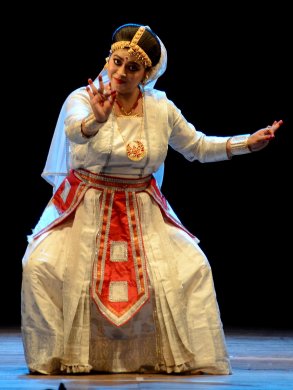 Jollymoni Saikia Jollymoni Saikia from Guwahati started her performance with a Vandana on the second day of the festival. Her prayer to the Lord was a typical Sattriya dance, where the movements were arranged to bow to the Lord and also hand gestures and head movements towards the audience conveyed the dancer's salute to them. She moved on to perform an abhinaya item. The story is based on the divine deed of Lord Krishna. While Lord Krishna was a king, his friend Bipra Damodara was a destitute. At his wife's insistence Bipra Damodara decided to approach Lord Krishna to seek help. Not wanting to go empty handed, he decided to carry some rice crispy, all that he could afford. As Bipra Damodara reached Krishna's palace, the Lord rushed out of the palace to greet his friend and made him sit on the throne. Krishna mischievously asked his friend what he got for him. Bipra Damodara was embarrassed to offer the meagre rice crispy; however Krishna snatched it from his friend's hand and stuffed it in his mouth. Upon coming back home Bipra Damodara found his house mysteriously turned into a palace with all riches. The abhinaya is based on Ojapali style. The concept is by Dhrubajyoti Pathak, who was also the conductor of the performance and played the khol. Jollymoni portrayed the characters with ease and the item had alterations of nritta and nritya, a typical character of Indian dances. The performance also had dialogues bringing in the qualities of natya and also the scope to elaborate the abhinaya. The other accompanists were Arunava Jyoti Malakar (khol), Debo Sankar Barman (vocal), Nabojit Saikia (flute), Anand Dixit (sitar) and Kankan Jyoti Das (cymbals). 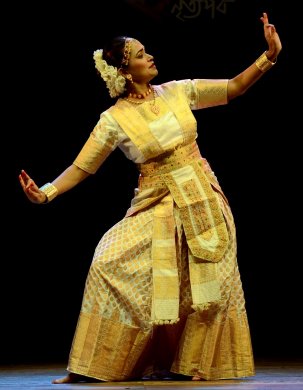 Mridusmita Das Borah The third day had two solo recitals. The artists were Mridusmita Das Borah from Guwahati and Gaurab Kumar Dutta from Jorhat. Mridusmita, a competent dancer of Sattriya, has an impressive academic background. She is also the recipient of the Ustad Bismillah Khan Yuva Puraskar. She is a disciple of Guru Ramkrishna Talukdar. She commenced her recital with a Krishna Vandana, "Krishna eko devo dukhahari", the lyrics in Naam Ghosha of Sri Sri Madhavadeva, followed by the second Ramdhani of Rajagharia Chali in Surtal composed by her Guru. She concluded her performance with excerpts from Krishnalila in Sanchari Bhava, "Stavak ek bhav anek" in raga Mahoor, taal ektal. Her presence on stage was attractive as she swayed through the different poses of Krishna and Vishnu. The use of hand gestures, body bends and the different positions of thigh ornamented the Rajaghoria Chali. The exposition of the Mati Akhoras or the basic movement units of Sattriya dance was excellently portrayed. Giren Kalita on khol reciting the bols was an added dimension to the performance. The other accompanists were Bhupen Nath (vocal), Prasanna Baruah (flute), Dwipendra Sharma (violin). 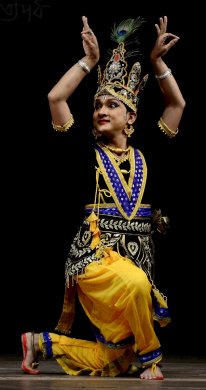 Gaurab Kumar Dutta Gaurab Kumar Dutta made an impact as he entered the stage. He was in traditional Krishna attire and his physique seemed perfect for the dancing Krishna. The purusha ora or the basic stances were perfectly displayed. Gaurab, who received training under Rameswar Saikia Borbayan and Nilamoni Borbayan of Natun Kamalabari Sattra, also took tutelage under Tankeswar Hazarika Borbayan. A very talented artiste, Gaurab started with his own composition on Srimanta Sankaradeva's Keli Gopal Naat, where Krishna nach, Nandi Shloka, two other shlokas and one song of Auniati Sattra's Sri Sri Dharmeswar Dev's writings were featured. Gaurab performed the essence of the story, where the gopis took away the clothes, flute and bangle of Krishna while dancing in the Rasalila. Alternating between the different characters much efficiently, Gaurab's solo presentation was thoroughly enjoyed by the audience. The able accompanists with him were Bhairabjyoti Dutta (khol), Nilamoni Borbayan (taal), Pranab Dutta and Paresh Chandra Bora (vocal), Nilotpal and Robin Bora (flute). 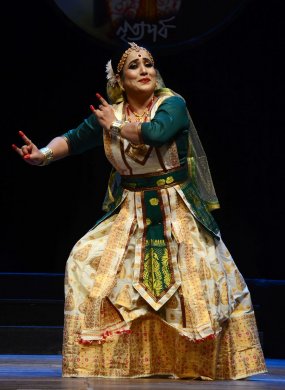 Sitarani Hazarika The solo presentation on the last day was by Sitarani Hazarika of Guwahati. Disciple of Guru Ghanakanta Bora Borbayan, she is an expert of Bihu dance too and is known as the Bihu Samragi. She started her performance with a dance on Ghosha of Sri Sri Madhavadeva followed by Kalakatiya Chalinas Ramdhani part on Suta and Thukoni tala. The accompanying song to the Chali nritya geet part, the borgeet of Srimanta Sankaradeva was performed on raag Dhanasree and taal Parital and Ektal describes the exquisite beauty of Sri Krishna and his magnificent costumes. Sitarani showed her abhinaya skill in this item, which was intercepted by rhythmic syllables. Her style blended the Bihu folk elements and hence her presentation bore stamp of the folk tradition of the area. The accompanists were Debajut Saikia on khol, Debsankar Barman on vocal, Prasanna Barua on flute and Manjit Saikia on taal. The Duets There were nine duets in the four days of the festival. Naturally eighteen artists got the opportunity to showcase their talents. Distinctly these performances put forward the popularity and the exceeding interest in pursuing this dance form among the young artists. Also the necessity of innovative items for stage was felt and it is seen that the Gurus are exercising their creativity in new compositions and choreography. One noticeable feature is the use of music for abhinaya items. The sanchari is flowered on the music instead of on the lyrics. Such experiments for stage are welcome but whether this will add to the new repertoire style remains a decision for the future. The first day featured three pairs of budding artists. The first duo Manjil Kalita (Sivasagar) and Utpala Hukai (Karbi Anglong) started their performance Ramdani part of Jhoomura naas and the story of Kamsavadh as described by Srimanta Sankaradeva. The story is taken from Ramcharan Thakur's play Kamsavadham. Jhoomura was introduced by Sri Sri Madhavadeva. Their performance was interesting with the use of bols, songs and dialogues. A complete natya was witnessed in a duet recital. The use of the different hastas to express the theme was very thoughtfully performed. The depiction of the Kubja by Utpala needs special mention here as her body gesture was well rehearsed. The music accompaniment helped the duo, where Pratyut Pratim Saikia played the khol, Paramananda Kakaty Borbayan was on vocal and violin, Manoranjan Bera was on flute and Nripen Kakaty played the Sankha and the taal. They ended the performance after the Kamsa Vadha with a Vandana, "korila bandono duiku pawye". 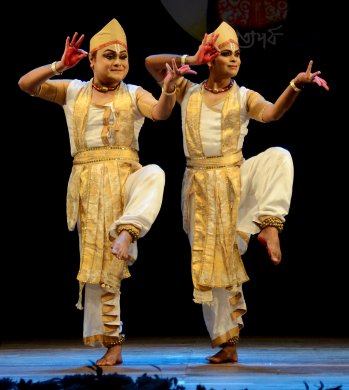 Dipjyoti Das and Dipankar Arandhara The next duo Dipjyoti Das and Dipankar Arandhara of Guwahati received the Ustad Bismillah Khan Yuva Puraskar this year. They are disciples of Guru Ramkrishna Talukdar and have extensively performed in many festivals. They started their performance with Sutradhari Nritta, which is a pure dance form of Sattriya where the Sutradhar takes the centre stage. Sutradhar is the protagonist in Ankiya Nat, written by the great saint Srimanta Sankaradeva. The Sutradhar introduces different characters of the performance and also expresses the unplayable parts of an Ankiya Nat. Both these artistes showed great control over the movements as they started with the mandala ora pada in purush ora stance moving on to the usual pranam and then performing the chali and dance on the song "Hare Rama, Srikrishnaya Vasudevaya, Govindaya namoh namaha" as they did the Krishna Vandana, a song glorifying Lord Krishna. They enacted the different aspects of Krishna's life, like the crossing of Yamuna by Vasudeva with Krishna in the basket on his head, while Vasuki holds the hood as an umbrella, the cowherd grazing cows and other incidents. They have used excellent bhramari movements ornamenting those with the Lahi Ora Pada and Phul Ora Pada. The final presentation was an abhinaya, Moksha based on the hymn 'brahmaadhikori' which is a part of Namghosha composed by Madhavadeva and Gajendra-upakshyan, which is included in the Ketanghosha composed by Srimanta Sankaradeva. The item depicted the prayer, 'O Lord, we are unconscious. Save us as you had saved Gajendra from Grahan. Light up our path with peace and help us to attain moksha." This item is choreographed by the duo. While expressing Gajendra, the duo composed the different aspects of the Lord in a very befitting manner. The audience was captivated in their performance. The able accompaniment deserves special mention. Music is composed by Bhaskarjyoti Ojah, who also played the khol. Bhupen Nath (vocal), Dwipendra Sharma (Violin), Nabajit Saikia (flute) and Babul Arandhara (taal) were other accompanists. The last duo performance was by Jimani Kacari of Goalpara and Krishnarani Konwar of Guwahati. Both are the disciples of Guru Govinda Saikia Borbayan. The presentation was the Suddha Chaali naas on raga Sareng and tala Suta-ektala choreographed by Guru Govinda Saikia, assisted by Dr. Dimple Saikia. The use of the prakriti ora was very discreet here. The simple steps were put together in a series, which were performed with dedication, but more synchronization was called for. The abhinaya item was the Gopikrishna milan, which is a story from the Rasapanchadhyayi of Srimad Bhagavat. The song "Nachata nabanagara natabara naba ramani sange" was used and it is beautifully tuned. Both the artistes made efforts to portray the story of the disappearance of Krishna as Radha tries to climb to his shoulders. The repentance of Radha was wonderfully sung by the vocalist Nitumani Kalita, who possesses a soft, expressive voice. The khol played by the Guru himself was an asset of the performance. Other accompanists were Prasanna Baruah on flute and Mousumi Borah on taal. The second day featured two duet presentations, Prarthana Dutta and Antara Goswami from Sivsagar and Guwahati respectively and Rimjhim Chutia and Prastuti Dutta from Sivasagara. All these four artistes are very young and showed much talent of dancing. Prarthana and Antara are learning khol and hence their understanding of the rhythm of dance reflects in their presentation. Both Rimjhim and Prastuti are being trained under Guru Jatin Goswami and their presentation stood out among all other performances on that day. Prarthana and Antara performed Kaliyamoksham. They started with a Shuddha nritta on a number of Ramdani Chalis and moved on to Meghashyamala. This starts with the shloka taken from the Ankiya Nat Kaliyadaman describing the greatness of Lord Krishna. The dance is composed on the theme of the cowherd boys playing on the river bank and the encounter of Lord Krishna with Kaliya. Both the artistes expressed the theme with sincerity and ease. 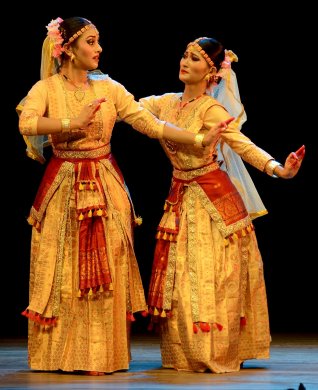 Rimjhim Chutia & Prastuti Dutta Rimjhim and Prastuti presented the pure dance, Rajaghoria Chali number three. The abhinaya item is an excerpt from Kumaraharana, where the love saga of Krishna's nephew Anirudhha and King Bana's daughter Usha was the theme. The accompanists were Biswajit Bordoloi on khol, Dhrubajyoti Baruah and Amritprabha Mahanta on vocal, Prasanna Baruah on flute and Anjal Dutta on violin. The first impact of their appearance was attractive. They were well rehearsed and had an amazing synchronization all through. The composition of Kumaraharana is also an excellent one, where the songs, bols and music mingled into one creation. The colours of the costume were well thought of and impressed the audience. On the third day, the first pair was Bishal Bora and Arunima Kalita and the second pair was Bismita Dutta of Jorhat and Ritusmita Deka of Majuli. Bishal and Arunima presented Yagyaseni. They started their presentation with Jhoomura Ramdani and gitar naas. In Yagyaseni the Pasha-khel, Vastraharan and finally ended with the Dushashan-vadh. It is conceptualised by the duo under the supervision of Rekha Moni Baruah. After the usual Vandana and nritta performance Bishal and Arunima very ably moved on to the abhinaya, where the expressions to portray the Vastraharana was competently placed. The male characters by Bishal, particularly Dushashan were well articulated. Arunima supported with equal ability in the character of Draupadi. The costume in white and pink added to their presentation. The live orchestra of khol (Hemanta Mahanta), vocal (Prasanta Das), violin (Anudhriti Mahanta), flute (Durgeswor Borah) and taal (Rekha Moni Baruah) provided the required back-up to the artistes. Bismita and Ritusmita started with Krishna Vandana. They performed the shloka-dance, chali dance of Ramdani. In abhinaya they performed Sarat Varnana of Srimanta Sankardeva, which is inspired from the description of the Sarat ritu in the 10th chapter of the Srimad Bhagavat. The concept and choreography of this is by Bismita Dutta. Both the artists enacted the elements of the season very efficiently. The use of the usual Mati Akhoras and the hastas to depict the lyrics was evident in their presentation. The accompanists to this duo were Monoranjan Borah (khol), Minakshi Lahkar and Pradyumna Borah (vocal), Pranabjyoti Dutta (flute) and Nilotpal Bora (taal). 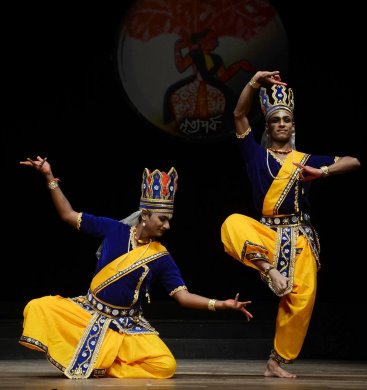 Biraj Roy and Sandip Kundu The last day featured the Bengali duo Biraj Roy and Sandip Kundu, disciples of Guru Sreemoyee Borah. They started with Krishna Vandana in taal ektaal and raagas Dhyanasree, Gouri and Kalyan. The music was by Kamalakshi Saikia and choreographed by Sreemoyee Borah. After this impressive beginning, the duo went on to perform Nadubhangi Ramdani part with Geetor part in talas Pari, Pari Jaman, Jaman, Jyoti and Sarubisham. Choreographed by Sreemoyee, the stalwart masters like Guru Jatin Goswami, Manik Bora Borbayan, Narendra Khataniar Borgayan provided valuable guidance to this. They were accompanied by Niranjan Hajarika (khol), Uddipta Narayan Das (vocal), Mousumi Borah (flute). The Bengali duo thoroughly impressed the audience with their dance. Every step and the style too were well executed. The popularity of this form has crossed the boundaries of Assam and it is heartening to see this dance gain recognition India wide. The other duet was by Mimon Mahanta of Jamugurihat and Ritumoni Pator of Guwahati and disciples of Guru Ramkrishna Talukdar, who played the taal. The duo started with a Prarthana and moved on to perform the Rajagharia part of Chali Naas. In the abhinaya, she performed the abhisarika nayika. This shringar rasa based item depicted the union of Krishna and gopi in a dream. The abhisarika nayika was depicted with all the nuances of the character. Most of the dance was composed on music and without any lyrics. The flute played by Prasanna Barua played a significant part here. Only at the end the popular song 'nachata nabanagara natabare ramani sange', sung by Bhupen Nath, was used. The khol was played by Giren Kalita and Dwipendra Sharma played the violin. The Trios There were four Trio presentations, one on each day. On the first day, the Sattriya Sangit Vidyalaya, Dibrugarh, presented three artists from their school, Manik Bora, Apsara Gogoi and Shreya Goswami. They presented Purnangarupa Sattriya Jhoomura Nritya. This is directed by Khireswar Hazarika in raag Behag and taal gitornasot jyoti, melanasot melajyoti, who also was the Bayan. The other accompanists were Arun Hazarika on vocal, Aswini Saikia on flute and Anmana Sharma Hazarika on taal. The program started with hailing the lord and with sounds of 'ta, na, nana, nane, riri'. After completing the ritualistic pranam the artistes went on to perform on the bols of the khol, while flute was played through the khol play. The song taken did not have much variety in the tune. The composition had light foot movements, repetitive movements, very simple hand gestures and rhythm variation from slow, medium to fast, thus taking the performance towards the folk genus. The artistes needed more coordination. The second day featured three artistes from Nupur Nrityangan, Tezpur, for the trio performance. Under the leadership of Rubi Borah Bordoloi, the performance started with a Krishna Vandana followed by the Rajaghoria chali. The selected abhinaya item was Ramabijoy written by Srimanta Sankaradeva, which showcased Sita talking to her friends about the sarvaguna sampanna young prince, Rama. Dialogues were woven in-between the khol play. Dances were composed on the songs describing Rama. The item moves on to Sita Swayamvar, where the breaking of the dhanus was portrayed in a usual manner. Ruby enacted the character of Rama. The item concluded with the Ram Vandana. The other two performers with Rubi were her disciples Violina Bordoloi and Nikita, both talented and have experience in performances of Sattriya. The third day the trio presentation was by Mitali Kala Kendra, Guwahati, the institute of famous Garima Hazarika, who is an Odissi dancer too. The three dancers were Dimee Medhi, Purbasha Bharadwaj and Sanskrita Baruah, all disciples of Guru Naren Chandra Baruah. The beginning of the performance was with the Nagada played by Bipul Ojha, which sounded gorgeous and loud. They began their performance with Iswar Vandana, "Karunamoy rakorio kripa jeno Rama". This has a traditional tune and the Vishama taal. The dancers took the centre stage one by one and took rounds anticlockwise. Then they went on to perform the Ramdani of Suddha Chali. The girls wore ghuri (ghagra) in this item. The bols were recited in all the tempos by the khol player and Guru Nagen Chandra Baruah himself. In the next item the girls changed into dhoti. The abhinaya item was based on the five avatars as described by Srimanta Sankaradeva in the Kirtan Ghosha. The talas used were ektaal, druta ektaal and chutkala. The avatars were well choreographed with the trio. On the last day, Boby Rani Talukdar, Dipti Devi and Sangita Lahkar from Guwahati presented a Trio. They presented three items. Beginning their presentation with Krishna Vandana, they went on to perform Gopinaas followed by Gopinath Smaranam based on Sankaradeva's borgeet "Suno suno re suno". The choreography was accurately presented. The expressions illustrated the theme nicely. The accompaniments Bhaskar Jyoti Ojah (khol), Luna Bharali and Krantika Sandilya (vocal), Dwipendra Sharma (violin), Nanbajit Saikia (flute) and Nirmali Deuri (taal) also added to the performance. The Group 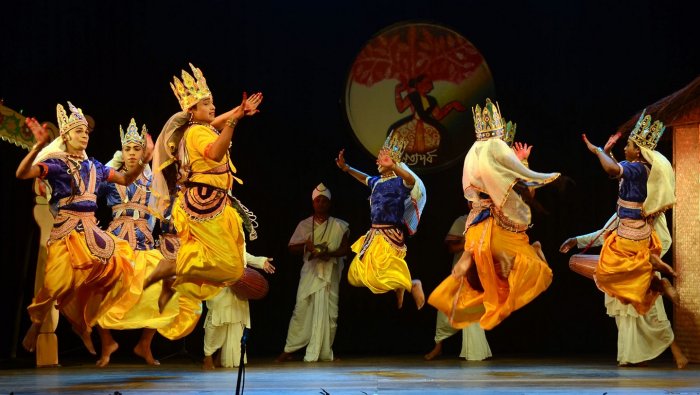 Uttar Kamalabari Sattra Sankardev Kristi Sangha, Majuli The group performance on the first day was by Uttar Kamalabari Sattra Sankardev Kristi Sangha, Majuli. The performance is divided into nritt or Ramdani and nritya or gitor naas. The abhinaya dance depicts Lord Krishna's pastime with his cowherd friends. The singers or the gayans describe this and the accompaniment is provided by the instrumentalists or the bayans. The performers are from the Sattras, where they stay and the gayan-bayans are in their regular spiritual practices. The participants in the group dance were Paramananda Gayan, Mridul Saikia, Niranjan Saikia, Prabhat Neog, Lakhyajit Saikia, Lakhiram Khataniyar, Tapan Kalita and Manas Borah. The bayan participants were Bhaben Barbayan and Jagannath Barbayan while the gayan participants were Upen Bargayan and Tirtha Bhuiyan Bargayan. The presentation was in the traditional style. The performers wore the traditional gosai prabesher costume of yellow dhoti and blue upper garment, chapkan. They wear a beautiful head gear, mukut, used by the cowherd boys. A cloth is hung from the head gear, cit. It was extremely interesting to note the feet, hand and head movements in its traditional form that has inspired the stage version of the Sattriya dance. As the gayans started the singing without any support tune instrument, one can realise and experience the nascent form of the dance in the Sattras. The dedication of these monks was amazing and the presentation mirrored the unique customs for this traditional theatre. The first group performance on the second day was by Badala Sattra of Narayanpur, which was established by Sri Sri Madhavadeva's disciple Sri Sri Badala Padma Ata Sattra. They performed Jhoomura, which was introduced by Madhavadeva. This is originally a male dominated dance. The word jhoo means vayumandal or the wind environment and mura means to take rounds. The rhythm used is called the Jati taal. The performers put on the ghuri or a ghagra type dress with a full sleeve chapkan. The four dancers wore the pag on the head. They presented the dance as is performed in the Sattra. With simple footsteps and some Mati Akhora the compositions were brought to the stage. Dr Bhupen Hazarika Centre for Studies in Performing Arts, Dibrugarh University, performed a group presentation. This centre preserves, promotes and propagates the Performing Arts of Assam. The artists performed Rajaghoria Chali number four, Ramdani gitor naas and mela naas. The group consisted of six female dancers and one male dancer. The presentation was commendable especially because the team represented a Centre of the University. It is very encouraging to note that the Centre is doing very good work in this field. Manjary Dance Academy presented group Sattriya dance on the third day. They presented Brahmaadi kori, an excerpt from Nam Ghosa composed by Sri Sri Madhavadeva. They first offered salutation to the Lord followed by Chali Ramdani, a pure dance set to tala thukoni and suta. Chali dance describes the elegance of Prakriti. Next they performed an abhinaya on the borgeet "Mohana manohara muruti madhava", composed by Sri Sri Madhavadeva in raag Gouri and taal ektaal. Their concluding dance, mela naas on ektaal was brilliantly performed and gained the praise of the audience. Sri Sri Kamalabari Sattra Krishti Prachar Samiti, Titabor, presented a group performance on the last day. A unit of the Sri Sri Kamalabari Sattra in Majuli, established by Sri Sri Badala Padma Ata, much-loved disciple of Sri Sri Madhavadeva, is dedicated to the promotion of Sattriya culture. It was a pleasure to see this Samiti perform.  Luitor Paror Agni Sur The festival came to an end with a mesmerising dance drama Luitor Paror Agni Sur or The fiery tunes of the bank of Luit (Brahmaputra). Choreographed by Anita Sharma, this production stood apt for celebrating the 75th year of independence of India. With many historical incidents for the freedom struggle, the production used nostalgic songs and lively commentary. The total presentation stood out for its brilliant conception. With elements from the Sattriya dances, the signature of Assam had been deeply carved in the production. Seminar 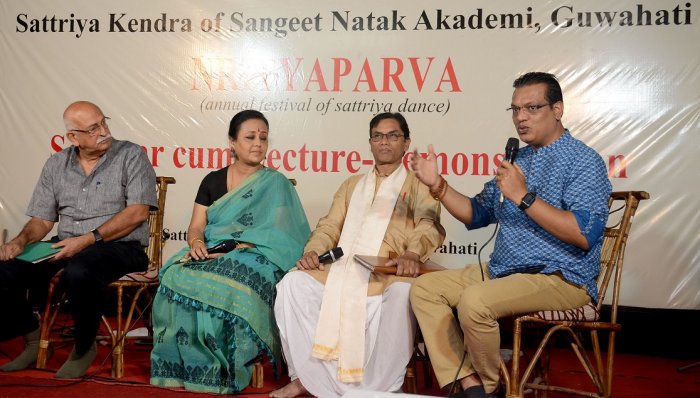 Ashok Sagar Bhagat, Prateesha Suresh, Muhikanta Bora Barbayan and Raju Das A very essential and fundamental part of the festival was its 3-day seminar, in which variety of topics were taken up and discussed thoroughly. On the first day, Muhikanta Borah Barbayan demonstrated essential elements of Ojapali and how those have influenced the abhinaya part of the Sattriya dance. Prateesha Suresh spoke on 'Hermeneutics of the Sattriya Tradition', which invited considerable discussion with the established dancers. Dr Mallika Kandali debated on the use of the hasta movement in gayan bayan leading to a very healthy interaction. Ashok Sagar Bhagat spoke on a very important element of creativity. He discussed how to design the presentation in dance production. A considerable time was devoted to the design in solo presentation, which turned out to be a very fruitful one. 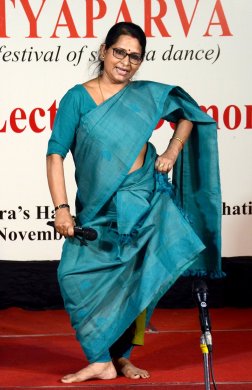 Madhurima Goswami 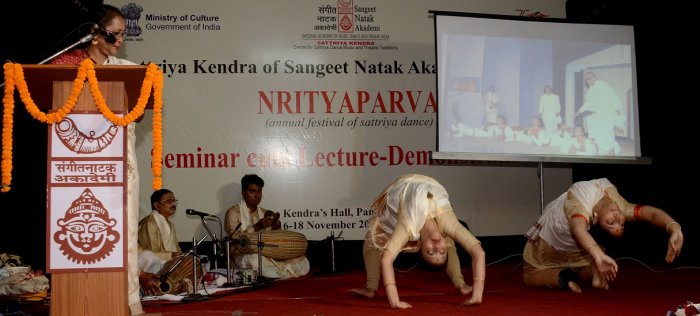 Ranjumoni Saikia Saroja Vaidyanathan's talk on 'The bha-ra-ta of Natyam over the ages' turned out to be truly rewarding for the young generation of dancers, on the second day. The senior dancer displayed her understanding and knowledge of the dance art through her experience of half a century. She explained how through the performing arts India is united in spiritualism. Madhurima Goswami's talk on the movement analysis ignited interest among the listeners and her research deserves special mention here. Her analysis of the static and the dynamic, regional expression and tensional quality of movement is noteworthy. Ranjumoni Saikia's talk on the Bayanor School was full of nostalgia. As she spoke of her father Guru Raseswar Saikia, the dancer community became emotional and the contribution of the great guru was remembered by senior dancers. 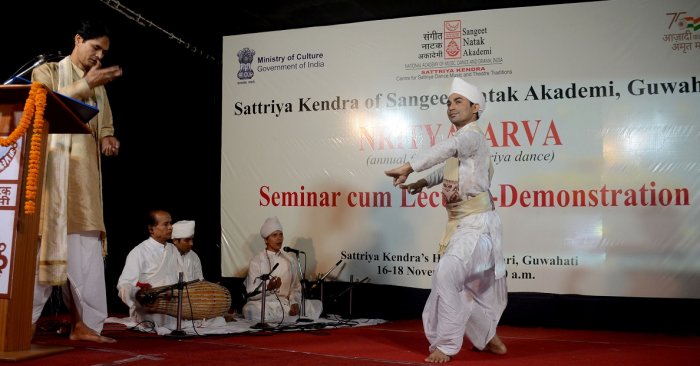 Kamalakanta Bhuyan 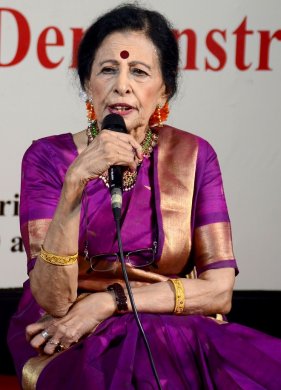 Saroja Vaidyanathan 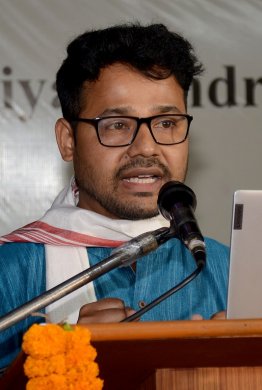 Baburam Saikia On the last day the seminar began with a perspective of tala of Sattriya dance by Kamalakanta Bhuyan. His knowledge of rhythm and its demonstration mesmerized all. Baburam Saikia spoke of the different challenges that the Sattras and its culture is into. Dr Arshiya Sethi offered a critical appreciation of the dances presented in the festival and elaborated on the different problems of continuing the Sattra culture in the modern era. She focussed on the changing scenario and its effect on the present Sattra culture in and out of its boundaries. She very strongly focussed on the necessity of preserving the culture, while being innovative in Sattriya dance presentation and propagation. 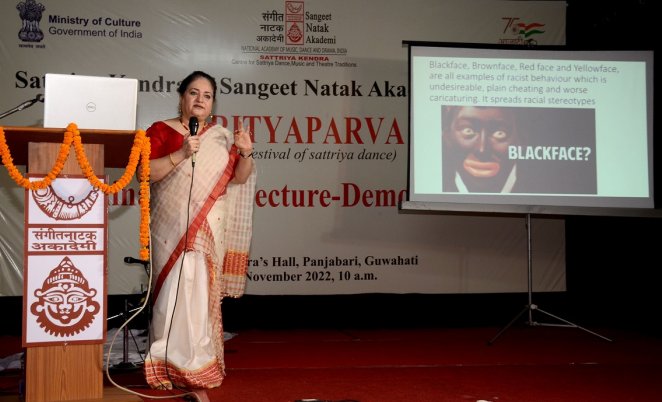 Arshiya Sethi All the four days of performances and seminar had an incredible impact on the audience, performers, listeners and observers. It was an enriching experience for all. A word of appreciation goes to all the members of the organising committee, who had worked hard for sheer love of performing arts of Assam to make this a success. It is one of the important events for Sangeet Natak Akademi every year. This successful initiative is the pride of Indian Performing Art genre. 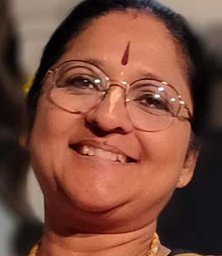 Prof. Dr. Sruti Bandopadhay is a rare combination of dancer-scholar having been awarded the Akademi Puraskar by Sangeet Natak Akademi in 2020. She is a 'Top' Grade in Manipuri dance by Doordarshan and is at present a Professor in Manipuri dance in Visva Bharati, Santiniketan. She is the recipient of the Fulbright Fellowship, the Commonwealth Fellowship for teaching and performing in the US and the UK respectively. She is awarded the DLitt in Manipuri Dance from Visva Bharati. She regularly performs, lectures and writes. She has five books and many articles on dance to her credit. |